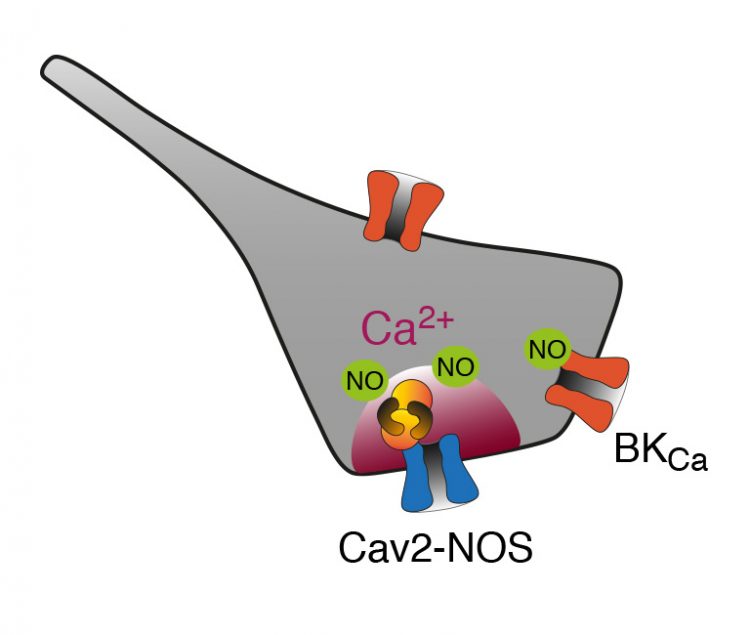How enzymes communicate

Electro-chemical coupling through protein super complexes: The calcium channel (Cav2) delivers calcium ions (Ca2+) that activate the enzyme NO synthase (NOS) for generation of the messenger NO. Source: Bernd Fakler
The enzymes nitric oxide (NO) synthase (NOS1) and protein kinase C (PKC) play an important role in a variety of signal transfer processes in neurons of the brain, as well as in many cell types of other organs.
Together with Prof. Dr. Bernd Fakler at the Institute of Physiology at the University of Freiburg, the scientists Dr. Cristina Constantin and Dr. Catrin Müller have shown for the first time that enzymes can be activated under physiological conditions through sole electrical stimulation of the cell membrane.
Protein super complexes that rapidly transform electrical signals at the cell membrane into chemical signal processes inside the cell emerge through direct structural interaction of both enzymes with voltage-gated calcium channels. The researchers have presented their work in the current issue of the scientific journal Proceedings of the National Academy of Sciences (PNAS).
The Fakler group has previously shown that both calcium-dependent enzymes NOS1 and PKC are components of the protein nano-environment of certain voltage-gated calcium channels (Cav2-channels) in the brain. As yet, however, it was not know how these enzymes communicate with the calcium channels.
The research group has now found that both enzymes are integrated into protein super complex with Cav2 channels. Within such Cav2-NOS1/PKC complexes NOS1 or PKC are anchored at the cytoplasmic side of the cell membrane and are placed at in the immediate vicinity of the channel pore.
Upon excitation of the cell membrane, the Cav2 channels open and deliver calcium ions to the cell cytoplasm, where they bind to both enzymes. Calcium binding activates the enzymes, which subsequently produce the diffusible second messengers NO or phosphorylate cytoplasmic target proteins.
Due to the proximity between channel and enzyme, electrical stimulations of less than a millisecond duration are required for effective electro-chemical coupling. The latter becomes maximal when the cell, instead of being stimulated by individual impulses, fires action potentials with a frequency of one hertz or more.
The Cav2-enzyme super complexes not only guarantee an ultrafast and reliable electro-chemical coupling. They also ensure that signal transduction remains locally restricted, that is, within an area less than a few nanometers around the Cav2 channels. This local restriction guarantees that the enzymes only initiate specific cellular processes, while other calcium signalling pathways, including cell death, are prevented.
In addition, the researchers’ experiments highlighted the physiological mechanism for activation of NOS1 and PKC thus presenting an alternative to the widely used synthetic activators, such as NO donors or diacylglycerols.
Bernd Fakler is the director of Department II of the Institute of Physiology and area coordinator of the Cluster of Excellence BIOSS Centre for Biological Signalling Studies at the University of Freiburg.
Originalpublikation:
Constantin, C.E., Müller, C.S., Leitner, M., Bildl, W., Schulte, U., Oliver, D., and Fakler, B. (2017). Identification of Cav2-PKC and Cav2-NOS1 complexes as entities for ultrafast electro-mechanical coupling. Proc Natl Acad Sci USA (in press).
Contact:
Prof. Dr. Bernd Fakler
Institute of Physiology, Faculty of Medicine / BIOSS Centre for Biological Signalling Studies
University of Freiburg
Tel.: 0761/203-5175
E-Mail: bernd.fakler@physiologie.uni-freiburg.de
Weitere Informationen:
https://www.pr.uni-freiburg.de/pm-en/2017/how-enzymes-communicate?set_language=e…
Media Contact
All latest news from the category: Life Sciences and Chemistry
Articles and reports from the Life Sciences and chemistry area deal with applied and basic research into modern biology, chemistry and human medicine.
Valuable information can be found on a range of life sciences fields including bacteriology, biochemistry, bionics, bioinformatics, biophysics, biotechnology, genetics, geobotany, human biology, marine biology, microbiology, molecular biology, cellular biology, zoology, bioinorganic chemistry, microchemistry and environmental chemistry.
Newest articles

First-of-its-kind study uses remote sensing to monitor plastic debris in rivers and lakes
Remote sensing creates a cost-effective solution to monitoring plastic pollution. A first-of-its-kind study from researchers at the University of Minnesota Twin Cities shows how remote sensing can help monitor and…

Laser-based artificial neuron mimics nerve cell functions at lightning speed
With a processing speed a billion times faster than nature, chip-based laser neuron could help advance AI tasks such as pattern recognition and sequence prediction. Researchers have developed a laser-based…

Optimising the processing of plastic waste
Just one look in the yellow bin reveals a colourful jumble of different types of plastic. However, the purer and more uniform plastic waste is, the easier it is to…



